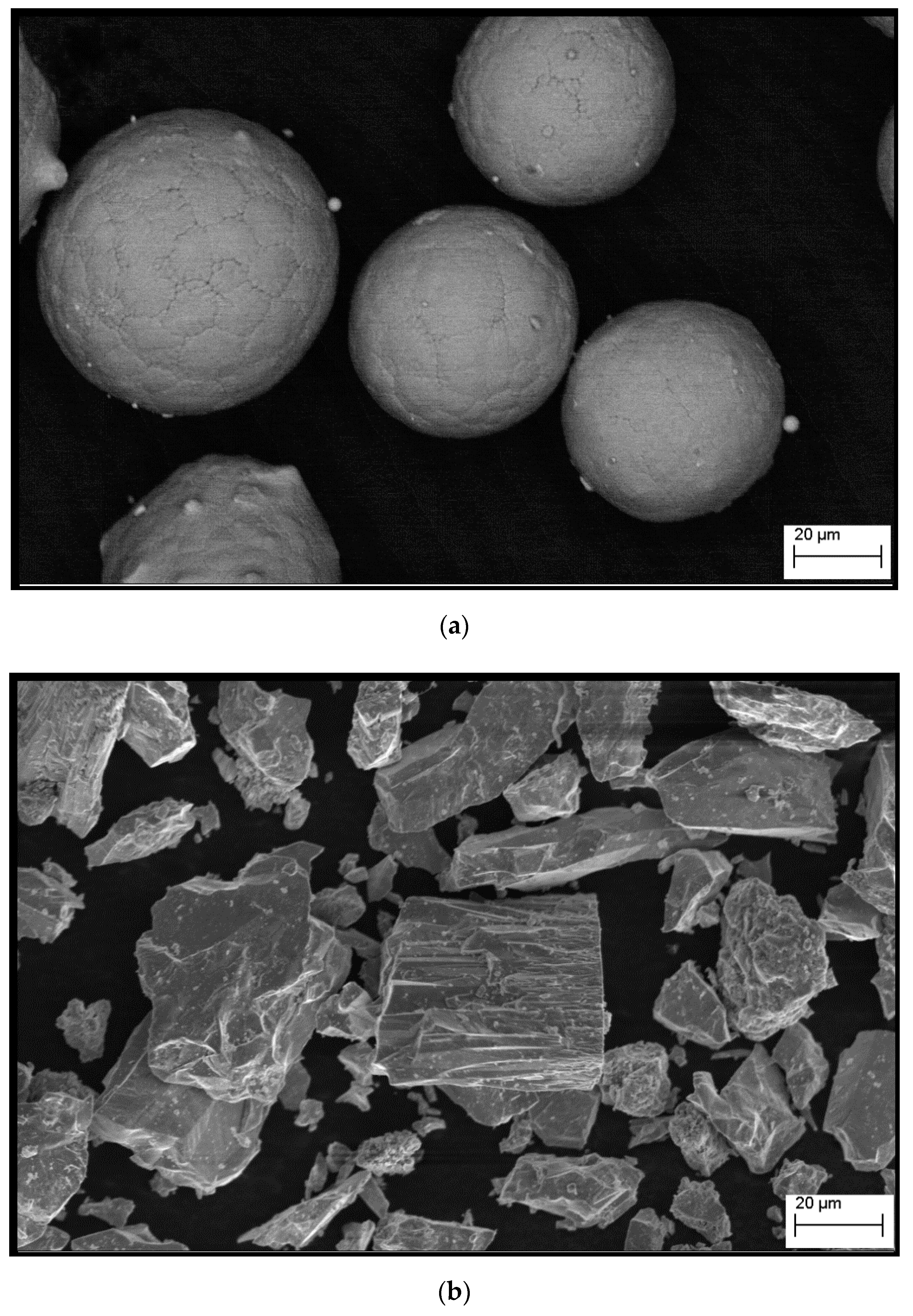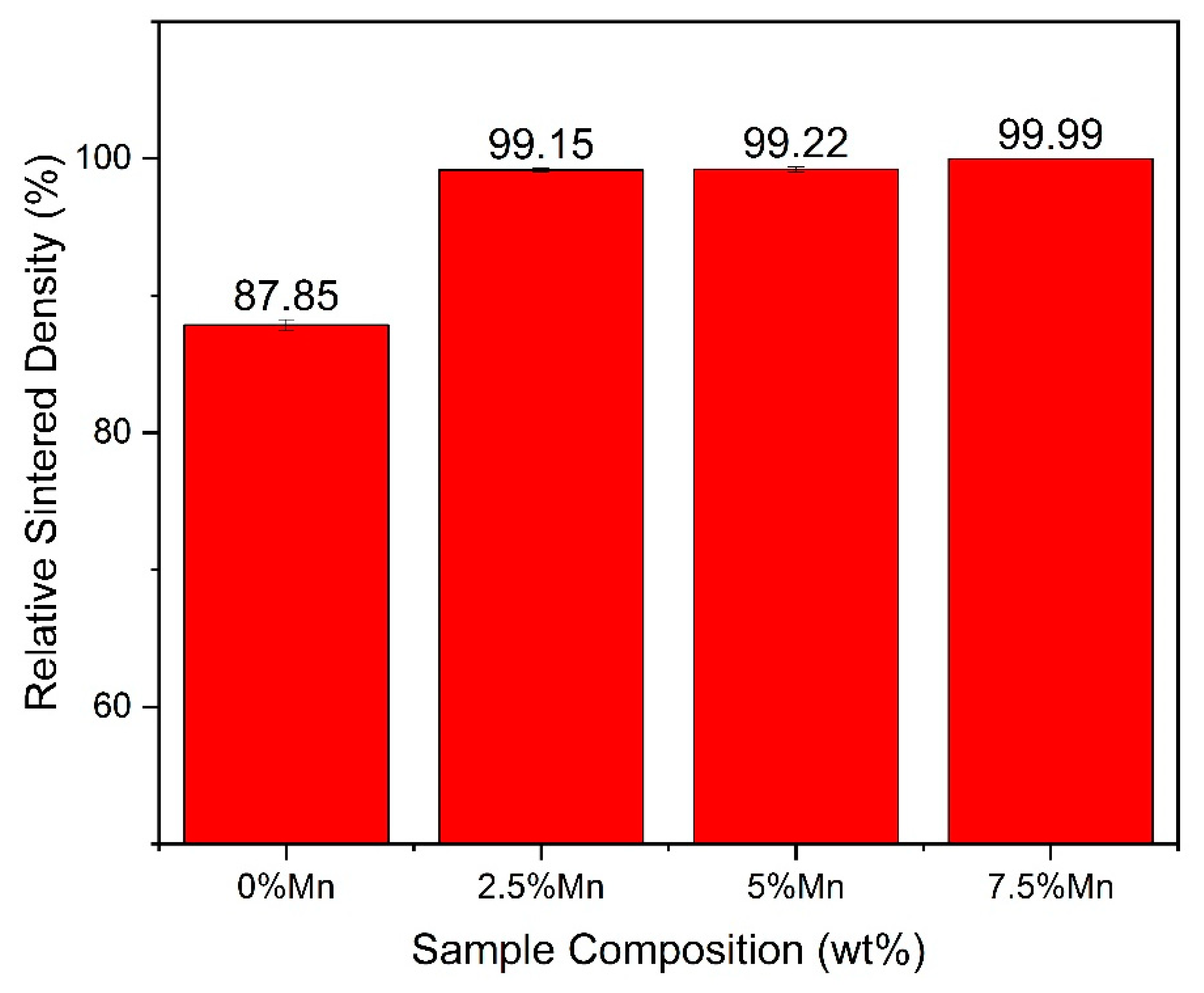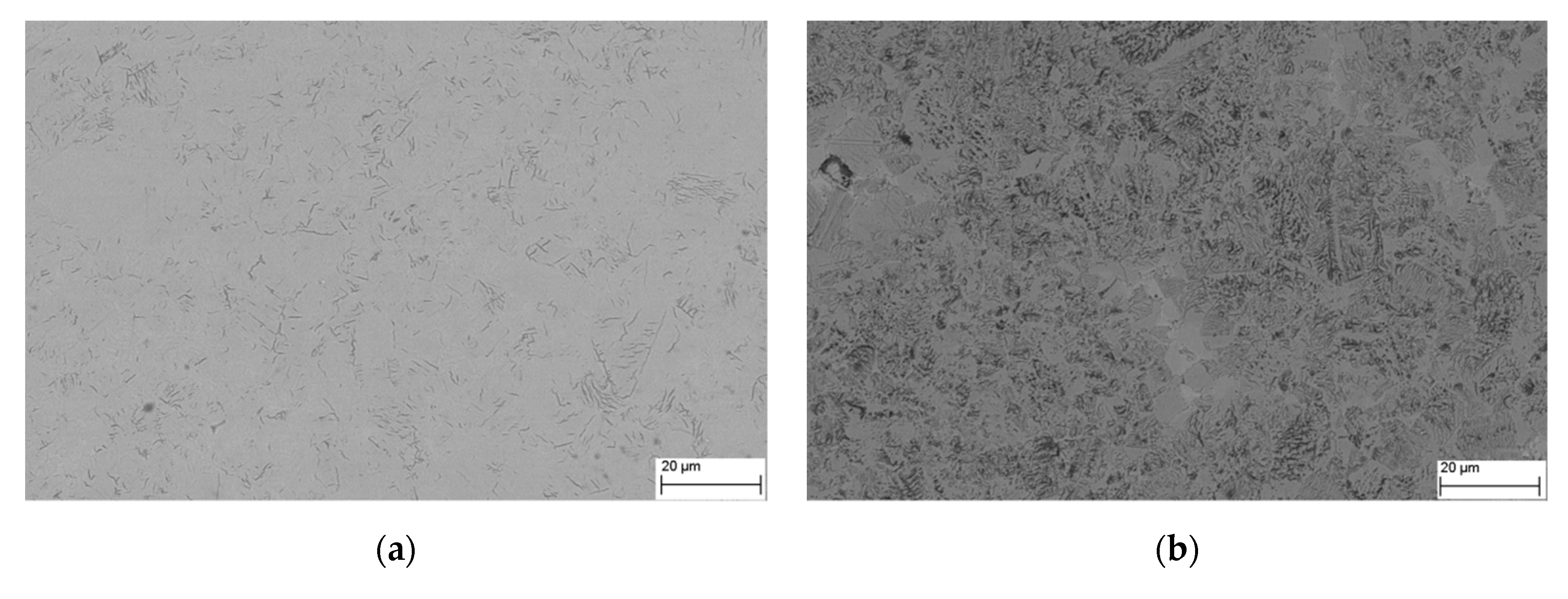Microstructure Evolution and Mechanical Properties of Spark Plasma Sintered Manganese Addition on Ti-48Al-2Cr-2Nb Alloys
Abstract
1. Introduction
2. Materials and Methods
3. Results and Discussions
3.1. Densification
3.2. Phase Analysis
3.3. Microstructure Characterization
3.4. Mechanical Properties
3.5. Fractography
4. Conclusions
Author Contributions
Funding
Conflicts of Interest
References
- Alman, D.E. Processing and properties of gamma Ti aluminide produced from PREP powders. Intermetallics 2005, 13, 572–579. [Google Scholar] [CrossRef]
- McCullough, C.; Valencia, J.J.; Levi, C.G.; Mehrabian, R. Microstructural analysis of rapidly solidified Ti-Al X powders. Mater. Sci. Eng. A 1990, 124, 83–101. [Google Scholar] [CrossRef]
- Qin, G.W.; Smith, G.D.W.; Inkson, B.J.; Dunin-Borkowski, R. Distribution behavior of alloying elements in α2 (α)/γ lamellae of TiAl-based alloy. Intermetallics 2000, 8, 945–951. [Google Scholar] [CrossRef]
- Xia, Y.; Luo, S.D.; Wu, X.; Schaffer, G.B.; Qian, M. The sintering densification, microstructure, and mechanical properties of gamma Ti–48Al–2Cr–2Nb alloy with a small copper addition. Mater. Sci. Eng. A 2013, 559, 293–300. [Google Scholar] [CrossRef]
- Guyon, J.; Hazotte, A.; Bouzy, E. Evolution of metastable α phase during heating of Ti48Al2Cr2Nb intermetallic alloy. J. Alloys Compd. 2016, 656, 667–675. [Google Scholar] [CrossRef]
- Stoloff, N.S.; Sikka, V.K. Physical Metallurgy and Processing of Intermetallic Compounds; Springer Science & Business Media: Berlin/Heidelberg, Germany, 2012. [Google Scholar]
- Gerling, R.; Clemens, H.; Schimansky, F.P. Fundamentals and applications of Ti alloys. Adv. Eng. Mater. 2004, 6, 23–38. [Google Scholar] [CrossRef]
- Kumagai, T.; Nakamura, M. Effects of aluminum content and microstructure on tensile properties of TiAl alloys. Scr. Mater. 1996, 34, 1147–1154. [Google Scholar] [CrossRef]
- Kardak, A.; Bilich, L.; Sinclair, G. Stress Concentration Factors for ASTM E8/E8M-15a Plate-Type Specimens for Tension Testing. J. Test. Eval. 2017, 45, 2294–2298. [Google Scholar] [CrossRef]
- Chemical Composition and Safety Data Sheet, Kroll’s Etch/E407/003, Item Numbers: PD1610-105-(250), PD1610-105-(500); Waterfall & O’Brien Ltd.: Bristol, UK, 2011.
- Clemens, H.; Lorich, A.; Eberhardt, N.; Glatz, W.; Knabl, W.; Kestler, H. Technology, properties, and applications of intermetallic γ-TiAl based alloys. Z. Met. 1999, 90, 569–580. [Google Scholar]
- Kim, J.W.; Hwang, M.J.; Han, M.K.; Kim, Y.G.; Song, H.J.; Park, Y.J. Effect of manganese on the microstructure, mechanical properties, and corrosion behavior of titanium alloys. Mater. Chem. Phys. 2016, 180, 341–348. [Google Scholar] [CrossRef]
- Wang, Q.; Ding, H.; Zhang, H.; Chen, R.; Guo, J.; Fu, H. Influence of Manganese addition on the microstructure and mechanical properties of a directionally solidified γTi-Al alloy. Mater. Charact. 2018, 137, 133–141. [Google Scholar] [CrossRef]
- Franti, G.W.; Williams, J.C.; Aaronson, H.I. A survey of eutectoid decomposition in ten Ti-X systems. Metall. Trans. A 1978, 9, 1641–1649. [Google Scholar] [CrossRef]
- Sun, F.S.; Cao, C.X.; Yan, M.G.; Kim, S.E. Alloying mechanism of beta stabilizers in a TiAl alloy. Metall. Mater. Trans. A 2001, 32, 1573–1589. [Google Scholar] [CrossRef]
- Shu, S.; Qiu, F.; Xing, B.; Jin, S.; Wang, Y.; Jiang, Q. Study of Effect of Mn addition on Ti2AlC/TiAl composites’ mechanical properties through first-principles research and experimental investigation. Intermetallics 2012, 28, 65–70. [Google Scholar] [CrossRef]
- Lee, T.K.; Mosunov, E.I.; Hwang, S.K. Consolidation of a gamma TiAl–Mn–Mo-alloy by elemental powder metallurgy. Mater. Sci. Eng. A 1997, 239, 540–545. [Google Scholar] [CrossRef]
- Kawabata, T.; Fukai, H.; Izumi, O. Effect of ternary additions on the mechanical properties of TiAl. Acta Mater. 1998, 46, 2185–2194. [Google Scholar] [CrossRef]
- Courtney, T.H. Mechanical Behaviour of Materials, 1st ed.; Waveland Press: Long Grove, IL, USA, 2005. [Google Scholar]
- Lapin, J.; Štamborská, M.; Pelachová, T.; Bajana, O. Fracture behavior of cast-in-situ TiAl matrix composite reinforced with carbide particles. Mater. Sci. Eng. A 2018, 721, 1–7. [Google Scholar] [CrossRef]
- Wang, J.; Luo, Q.; Wang, H.; Wu, Y.; Cheng, X.; Tang, H. Microstructure characteristics and failure mechanisms of Ti-48Al-2Nb-2Cr titanium aluminide intermetallic alloy fabricated by the directed energy deposition technique. Addit. Manuf. 2020, 32, 101007. [Google Scholar] [CrossRef]
- Chen, J.H. Brittle Fracture of TiAl Alloy and NiTi Memory Alloy. In Micro Mechanism of Cleavage Fracture of Metals; Elsevier: Amsterdam, The Netherlands, 2015; pp. 365–443. [Google Scholar]






| Powder | Ti-48Al-2Cr-2Nb | Mn |
|---|---|---|
| Particle size (µm) | 60 ± 6.1 | 30 ± 5.42 |
| Purity (%) | ~99.9 | ~99.9 |
| Density (g/cm3) | 3.9 | 7.3 |
| Composition | Theoretical Density (g/cm3) | Actual Density (g/cm3) | Relative Sintered Density (%) |
|---|---|---|---|
| Ti-48Al-2Cr-2Nb | 3.9 | 3.43 ± 0.04 | 87.86 ± 0.42 |
| Ti-48Al-2Cr-2Nb + 2.5% Mn | 3.95 | 3.91 ± 0.02 | 99.15 ± 0.15 |
| Ti-48Al-2Cr-2Nb + 5% Mn | 3.99 | 3.96 ± 0.02 | 99.22 ± 0.18 |
| Ti-48Al-2Cr-2Nb + 7.5% Mn | 4.04 | 4.04 ± 0.01 | 99.99 ± 0.03 |
| Composition | Yield Strength (MPa) | UTS (MPa) | Elongation (%) | Vickers Hardness (0.5 kgf) |
|---|---|---|---|---|
| Ti-48Al-2Cr-2Nb | 325 ± 6 | 516 ± 12 | 1.23 ± 0.2 | 303.54 ± 14 |
| Ti-48Al-2Cr-2Nb + 2.5% Mn | 345 ± 4 | 819 ± 23 | 1.7 ± 0.2 | 353.19 ± 12 |
| Ti-48Al-2Cr-2Nb + 5% Mn | 482 ± 9 | 690 ± 18 | 1.9 ± 0.1 | 354.49 ± 08 |
| Ti-48Al-2Cr-2Nb + 7.5% Mn | 536 ± 12 | 570 ± 23 | 2.1 ± 0.1 | 368.33 ± 15 |
Publisher’s Note: MDPI stays neutral with regard to jurisdictional claims in published maps and institutional affiliations. |
© 2020 by the authors. Licensee MDPI, Basel, Switzerland. This article is an open access article distributed under the terms and conditions of the Creative Commons Attribution (CC BY) license (http://creativecommons.org/licenses/by/4.0/).
Share and Cite
Annamalai, A.R.; Srikanth, M.; Varshney, R.; Ashokkumar, M.Y.; Patro, S.K.; Jen, C.-P. Microstructure Evolution and Mechanical Properties of Spark Plasma Sintered Manganese Addition on Ti-48Al-2Cr-2Nb Alloys. Metals 2020, 10, 1577. https://doi.org/10.3390/met10121577
Annamalai AR, Srikanth M, Varshney R, Ashokkumar MY, Patro SK, Jen C-P. Microstructure Evolution and Mechanical Properties of Spark Plasma Sintered Manganese Addition on Ti-48Al-2Cr-2Nb Alloys. Metals. 2020; 10(12):1577. https://doi.org/10.3390/met10121577
Chicago/Turabian StyleAnnamalai, A. Raja, Muthe Srikanth, Raunak Varshney, Mehta Yash Ashokkumar, Swarup Kumar Patro, and Chun-Ping Jen. 2020. "Microstructure Evolution and Mechanical Properties of Spark Plasma Sintered Manganese Addition on Ti-48Al-2Cr-2Nb Alloys" Metals 10, no. 12: 1577. https://doi.org/10.3390/met10121577
APA StyleAnnamalai, A. R., Srikanth, M., Varshney, R., Ashokkumar, M. Y., Patro, S. K., & Jen, C.-P. (2020). Microstructure Evolution and Mechanical Properties of Spark Plasma Sintered Manganese Addition on Ti-48Al-2Cr-2Nb Alloys. Metals, 10(12), 1577. https://doi.org/10.3390/met10121577









